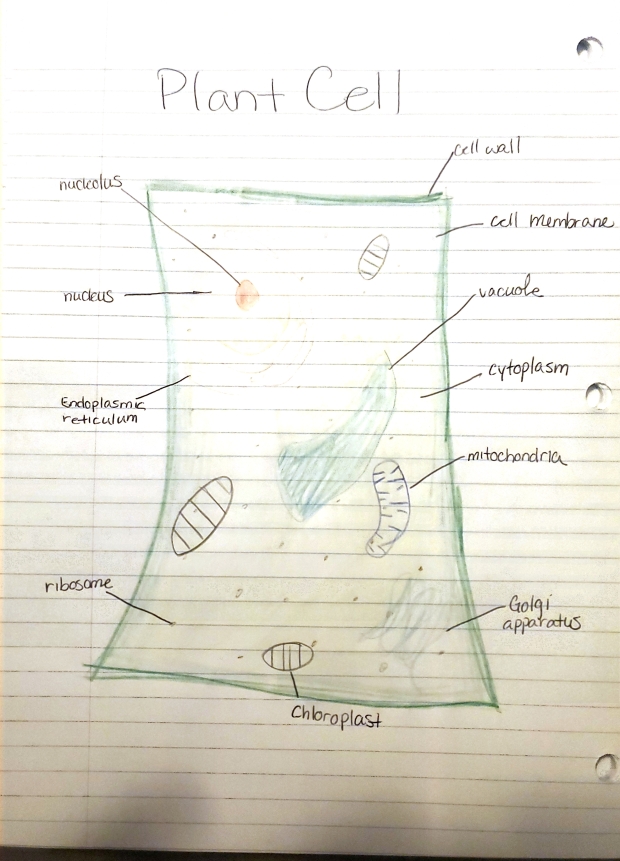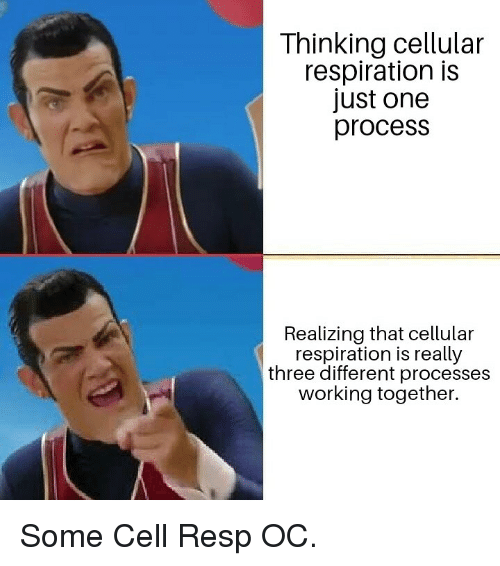Cell Biology
Plant Cells
Plant cells are eukaryotic cells, they have a nucleus and many organelles which are specialized to carry out very specific functions. Chloroplasts are an organelle very specific to plant cells, they create sugars via photosynthesis and contain the pigment chlorophyll which gives plants their green color.
Plant cells are also special in that they have cell walls which maintain the cells shape and provide support. Plant cells also contain a central vacuole which stores water, causing it to expand and pushing on the cell wall and making them strong.

Sucrose
Sucrose is a disaccharide made of one glucose molecule and one fructose molecule. Better known as table sugar, sucrose is produced naturally from plants. Extracted from sugarcane, the cane is crushed and produces raw sugar which is refined into pure sucrose.

Metabolism
This meme was chosen because much like the meme states I did not fully understand how cells metabolize and create energy for quite a while. I especially never realized that our cells create waste products, to think that our cells poop is odd.
file:///C:/Users/user/Downloads/thinking-cellular-respiration-is-just-one-process-realizing-that-cellular-8625bd8ec6fa48b3810effdada6c9c19.html
Scientific Writing
Cell division is key to every life form, as organisms we continue to grow and change. In order for this growth to occur our bodies must produce new cells which replace the old, damaged ones. Yet cells would not properly divide without some sort of regulation to ensure that the DNA has been copied correctly, therefore division occurs in a strict cycle that relies on stages and checkpoints to keep things in line (ER Services). The checkpoint which specifically checks the cell DNA for damage and correct replication is the G2 checkpoint. If damage is detected the cycle pauses and the cell attempts to repair the damage. If the damage cannot be repaired, the cell undergoes apoptosis or cell death (Khan).
In the article, which will be discussed later, we will talk about an analysis on zebrafish which have 25 pairs of chromosomes, making them diploid organisms (Postlethwait, 2000). Mitosis is the process of a cell replicating its DNA and dividing to produce two identical daughter cells. Mitosis occurs in five phases and finishes with the cytokinetic process. The first phase is interphase, specifically the S phase as a sub-phase, in which the cell’s DNA and centrosomes are duplicated resulting in two copies of the host DNA, the next is prophase in which the chromosomes condense, pair up and the nucleus dissolves. The third phase is metaphase, in which the chromosomes line up in the center of the cell with spindle fibers attaching to each side of the chromatids. Anaphase occurs next where the chromatids are puled apart to the poles, where they gather in telophase and a membrane form around each set to create a nucleus. The last piece is cytokinesis in which a pinch occurs in the middle, between the two nuclei and the cells split to become two identical daughter cells.
Figure 1 in the article seeks to aid the reader in understanding the overall point of the experiment. This experiment seeks to understand how and why the epithelial cells of zebrafish underwent such a process. The image with the multicolored cells is used to aid in visualizing the process the cells go through while also labeling them for the scientist to follow through the division process. Scientists utilized a special technique named palmskin to tag the outermost layer of the skin (labeled SEC) specifically targeting the cell membrane and making it easier to mark changes in cell shape and size (Postlethwait et al., 2022).
Figure 2 in this article takes the reader just a smidgen deeper into the view of the scientists. This figure aids in looking at the statistics and proportion of the cells after fertilization and how they proliferate. Part e of the figure shows exactly how after eight and ten days post fertilization how many “daughter” cells were created from the original host cell as the replicated, signified by cells sharing the same color and shade. It is seen in part e that by ten days post fertilization the cells had divided at an increasing number, but also the resulting cells seemed to be smaller also leading to a larger organism. Part f of this figure also seeks to show the number of cells that divided and how many times it divided, many divided on more than one occasion.
Figure 4 is one which brings most of this study together. It shows what may possibly be driving this type of cell division. Scientists raised three different population densities of zebrafish, shown in parts e and f of figure 4, and fish raised in lower density populations grew faster than those in a more competitive atmosphere. This figure also shows that those that grew faster had a higher propensity for more daughter cells from one original cell. This is just one key to what drives this type of cell division and what else could contribute to growth and eventual development.
Through this entire article, it seems these cells are not replicating through normal mitosis as the daughter cells do not come out identical to the parent cell. These daughter cells can come out smaller, with less DNA, not all daughter cells replicate, etc. This is part of the reason these scientists conducted such an experiment, to create a pathway to understanding how the body and world around us is evolving. This replication does not a meiotic in the slightest as the cells do not come from any reproductive source, so far this phenomenon has been seen in epithelial cells only. The reason for this phenomenon seems to be for growth and proliferation, to heighten one’s chances for survival.
References
Chan, K., Yan, C., Roan, H., Hsu, S., Tseng, T., Hsiao, C., Hsu, C. and Chen, C., 2022. Skin cells undergo asynthetic fission to expand body surfaces in zebrafish. Nature, [online] 605(7908), pp.119-125. Available at: <https://www.nature.com/articles/s41586-022-04641-0> [Accessed 17 June 2022].
Courses.lumenlearning.com. 2022. Why It Matters: Cell Division | Biology for Majors I. [online] Available at: <https://courses.lumenlearning.com/suny-wmopen-biology1/chapter/why-it-matters-cell-division/> [Accessed 20 June 2022].
Khan Academy. 2022. Cell cycle checkpoints (article) | Khan Academy. [online] Available at: <https://www.khanacademy.org/science/ap-biology/cell-communication-and-cell-cycle/regulation-of-cell-cycle/a/cell-cycle-checkpoints-article> [Accessed 19 June 2022].
Postlethwait, J., Woods, I., Ngo-Hazelett, P., Yan, Y., Kelly, P., Chu, F., Huang, H., Hill-Force, A. and Talbot, W., 2000. Zebrafish Comparative Genomics and the Origins of Vertebrate Chromosomes. Genome Research, [online] 10(12), pp.1890-1902. Available at: <https://genome.cshlp.org/content/10/12/1890.full.html> [Accessed 21 June 2022].
Yourgenome.org. 2022. What is mitosis?. [online] Available at: <https://www.yourgenome.org/facts/what-is-mitosis> [Accessed 21 June 2022].
Reflection
Cell biology is a course in which students are meant to learn about the structure and function of the cell. The cell is the smallest and most fundamental unit of life with some organisms are made of one cell and others are composed of millions of cells. Honing in on the cell allows us to understand the tissues and organs that they make up.
Throughout my time in this course, I have learned so much about how cell replication and DNA expression do not simply dictate what we see on the outside. Even the slightest error during replication can lead to a malfunction in how the cells function and lead to many diseases and disabilities. Many of these errors we still don’t know how they occur or what we can do to stop them from occurring. I am a biomedical science major attempting to prepare myself for veterinary school, and animals have these malfunctions occur more than people realize. Understanding how and why this happens can aid in being better able to find a source and a solution to these issues.

